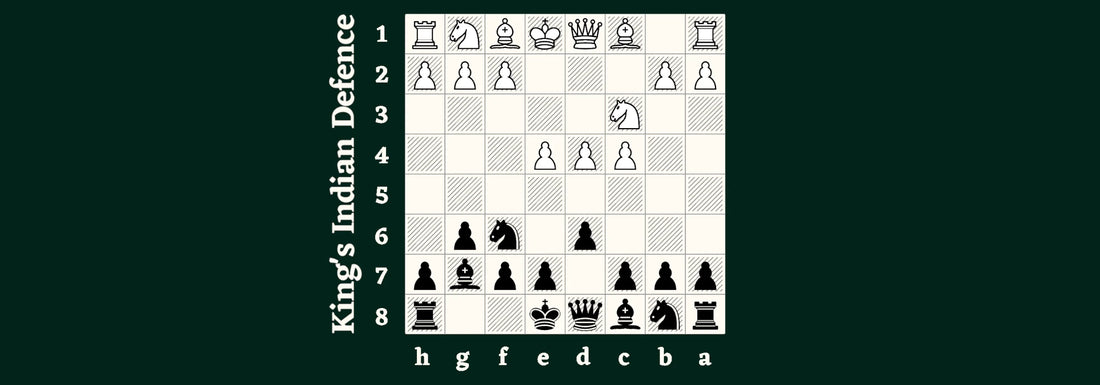The Indian Defence is a chess opening that originated in India in the first half of the 19th century and was often played there by the Brahmins. The opening is characterised by the fact that a defensive position is adopted right at the beginning of the game. The aim of the King's Indian Defence is to build a solid defence that allows the black king to remain safe while the rest of the chess pieces are developed. Instead of actively taking the centre, it is first left to White and then put under pressure by threats.

For this, first the knight is moved to target the centre. Next comes the move of the b- or g-pawn to make room for the bishop. As soon as the bishop has been moved to b7 or g7 and has taken the main diagonal from a good defensive position, it is called a fianchetto. In the following moves, depending on the tactical motive, Black now has the possibility to castle to the kingside.
The defence became famous through the chess player Mir Sultan Kahn, who played the Indian variations very successfully in the early 20th century. Savielly Tartakower popularised the naming of the Indian Defence and Hans Kmoch differentiated its different courses.
The different courses of the Indian Defence:
- King's Indian, with a fianchetto of the bishop on the kingside
- Queen's Indian, with a fianchetto of the bishop on the queenside
- Full Indian, when both bishops form a double fianchetto
- Half-Indian, when knight and pawn are drawn, but the fianchetto by a bishop is omitted.
Here the King's Indian Defence is the most popular and is characterised in the basic position by the following chess moves:
1.d4 ♘f6 2.c4 g6 3.♘c3 ♗g7 4.e4 d6
The opening gained more and more popularity over the years and was also used successfully by other chess players such as Mikhail Tal, Bobby Fischer and Garry Kasparov. Kasparov also used this opening frequently in his matches against Anatoly Karpov. The King's Indian Defence is one of the best and most popular openings for Black to White's move 1.d4.
Strengths of the King's Indian Defence
Even though Black initially leaves the centre to White with this opening, some advantages come with it:
- Stable Stance:
By focusing on the kingside early and moving the knight and bishop, castling can also be done early.
- Attack of the Centre:
Placing the bishop on the main diagonal puts pressure on the centre and at the same time targets the opponent's rook.
- Strong Attack Opportunity:
The King's Indian Defence allows a strong attack on the kingside, which is supported by the pawn structure in the centre.
- Quick Piece Development:
In principle, the King's Indian Defence allows a very fast development of the pawns, since the centre is given up for more speed.
Weaknesses of the King's Indian Defence
The defensive orientation of the defence also creates some disadvantages:
- Passive Approach:
White can freely occupy the centre with pawns, as only passive pressure is exerted by a knight.
- Bishop tied to the Diagonal:
Due to the placement of the bishop on the kingside, it occupies the main diagonal, but is otherwise less flexible than in a central position.
- Intention of Attack obvious:
Black is forced to put his emphasis on the kingside and to become active quickly in order to compensate for the disadvantages of the passive defence.
- Weakened Queenside:
Attacking options open up for White on the queenside, as Black shifts his play to the kingside.
Possible Courses of the King's Indian Defence
Due to the high popularity of the defence and its effectiveness against the white move d4, some common courses of play have emerged.
Classical Variation

Chess Moves:
1.d4 ♘f6 2.c4 g6 3.♘c3 ♗g7 4.e4 d6 5.♘f3 O-O 6.♗e2 ...
In the classical variation, the basic position is followed by White's move of the knight to f3 and then Black's castling. With the pawn's move to e5, Black can now prepare an attack on the centre. Alternatively, it is also conceivable to put the knight on f3 under pressure with the black bishop on g4 and to move the own knight from f6 to d7. This would support an attack with the e7-pawn and consolidate the centre.
Sämisch Variation

Chess Moves:
1.d4 ♘f6 2.c4 g6 3.♘c3 ♗g7 4.e4 d6 5.f3 ...
In the Sämische variation, White moves his pawn to f3 instead of the knight, thereby creating a defence against the black knight on g4 and preparing a counterattack on the kingside. In particular, White's g and h-pawns can advance well in this variation and put pressure on Black. The big disadvantage for White is the passive position of the knight, which has been deprived of its development square. In this variation, Black can try to focus the development of his pawns early for an attack on the centre. In this way, White's disadvantage can be exploited and the advance on the kingside can be stopped.
Averbakh Variation

Chess Moves:
1.d4 ♘f6 2.c4 g6 3.♘c3 ♗g7 4.e4 d6 5.♗e2 O-O 6.♗g5 ...
With the bishop on g5, the Averbakh Variation pursues the goal of preventing Black's pawn attack on the e-file. If Black were to move his pawn to e5, the pawns in the centre and the queens would capture each other. If White then moves his knight to d5, the square f6 is under double attack and Black loses his knight. Black therefore often displaces the bishop with his h-pawn or focuses the attack on the centre with 6...c5 to maintain the fianchetto.
Four Pawn Attack

Chess Moves:
1.d4 ♘f6 2.c4 g6 3. ♘c3 ♗g7 4.e4 d6 5.f4 ...
The Four Pawn Attack was very popular in the early 20th century, but had clear disadvantages for White. Thus, with the pawn move to f4, White neglects the development of his pawns and weakens his king’s side by resolving a stable castling position. Black therefore primarily strives to break the pawn chain and after castling often advances with the c-pawn on c5. Before that, the knight can also be moved to a6 to support the attack.
Conclusion
The King's Indian Defence is one of the best defences against the white opening with d4. Even though it is defensive at the beginning and leaves the centre to White, it allows for early castling and a quick development of the own pieces. The fianchetto also makes a coordinated attack on the centre possible in the later stages and at the same time supports an attack on the kingside. With its many possibilities and a solid defence, the King's Indian Defence is a very good choice for a Black player to prepare for White's d4 opening.
I hope that I could give you some helpful tips for the King's Indian Defence. If you have any further questions, please feel free to contact me via my contact form. And if you are interested in chess pieces or chessboards in tournament format, please have a look at my assortment.
I wish you a lot of fun with the game, much success and rapid progress in your learning.
See you soon.
Stefan

